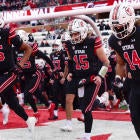They tried to talk Taj Griffin out of it.
The senior tailback had seen diminishing playing time through his four seasons at Oregon. As the Ducks trended toward a running-back-by-committee approach in 2018, Griffin touched the ball only eight times (six carries, two receptions) in the three games in which he appeared. As a freshman in 2015, he had been the Ducks' No. 2 rusher.
That was enough for the Powder Springs, Georgia, native, who became one of 10 players last week to take advantage of the NCAA's new redshirt rule. The rule allows players to appear in up to four games in a season without using a year of eligibility should they chose to redshirt.
The question for Griffin and scores of players taking advantage of the new liberalized rule: Did he know what he was doing?
By transferring, Griffin may have inadvertently ended his FBS eligibility. It's a piece of the new legislation that certainly not everyone has caught onto. Unless Griffin transfers to a program in Division II, Division III or junior college, he would have to sit out the remainder of this season as a redshirt year, as well as 2019 to satisfy the NCAA's traditional year-in-residence requirement for FBS transfers.
Griffin could still be eligible in 2019 if he were graduate early in December, but sources told CBS Sports that Griffin was "at best" a spring 2019 graduate. If so, Griffin's five-year eligibility clock will run out at the end of 2019. In anticipation of that possibility, those same sources told CBS Sports that Griffin was "counseled" about his decision. In other words, he was informed of the implications that his FBS college football career could be over.
"I do not think [the players] have a good handle on [the new rule]," said a source in NCAA governance who did not want to be identified due to the sensitivity of the situation.
"This is going to cause some problems, I'm sure," said Tim Nevius, an attorney in private practice assisting schools and athletes in NCAA matters. Nevius was previously an NCAA investigator and considered an expert at NCAA compliance issues.
"There's going to be an issue where an athlete thinks he's going to be eligible the next year, and he's not going to be eligible," Nevius added. "If it's his last year of eligibility and he hasn't graduated, that's going to be a serious problem."
Of the 10 players who announced their departure last week, four will be graduate transfers, including Clemson quarterback Kelly Bryant, who graduated last spring meaning he only had to take enough graduate courses this fall to stay eligible. His transfer status is relatively straightforward.
The confusion comes for undergraduates who must consider the possibility of losing their final year of eligibility. Griffin was the only undergrad in that group whose eligibility status CBS Sports could determine was in question.
"For the person who would transfer as an undergrad, it's not as straightforward," said Chad Hawley, the Big Ten's associate commissioner, policy. "This is sort of a wrinkle in the rule. The reason for adopting it is more for; there is no sport like football, the physicality. Let's have the flexibility."
The NCAA allows athletes five years to fit in four years of competition from the time of their initial enrollment. If Griffin has not accounted for sitting out the final eight games of 2018 and the entire 2019 season, he would be finished with his eligibility having played only three full seasons unless he receives a waiver from the NCAA.
"Here's what the issue is," Nevius explained. "If people are confusing the redshirt year with the year-in-residence requirement, it's going to be to the detriment of that athlete who says, 'I'm going to transfer and I'll be good next year.' If they're not fully informed, they're going to jeopardize their eligibility."
It's really no one's fault. The NCAA's byzantine rules are still, well, byzantine -- i.e. overly complicated. In that sense, it's up to the athlete -- and whomever is advising him -- to know the rules.
In every sport except football, men's and women's basketball, hockey and baseball, athletes are allowed a one-time transfer without sitting out a full season. The so-called "year-in-residence" for those main sports has been around since 1951. It was meant for athletes to get their academics in order at the new school.
As Nevius mentioned, some are confusing that decades-old rule with transfer reform. Beginning Oct. 15, coaches and schools can no longer "block" transfers from going to another school. Players will simply put their name in a portal which will be accessible to see a formalized list of transfers.
Auburn junior defensive back John Broussard is one of those players who last week declared he will become a transfer student. Broussard told CBS Sports he plans to sit out the rest of the season, transfer to Snead State Community College -- a Boaz, Alabama-based junior college -- take online classes and enroll in January at a new FBS school.
That would be similar to the path followed by Auburn quarterback Jarrett Stidham. After his freshman season at Baylor in 2015, Stidham transferred to nearby McClellan County (Texas) Community College for the fall of 2016. He enrolled at Auburn in January 2017 with three years of eligibility remaining.
Neither McClellan or Snead have a football program.
If Broussard carries enough credits forward, he would have two years of eligibility remaining. CBS Sports asked Broussard in a Twitter exchange if the average athlete has enough knowledge of the new transfer climate.
"I don't think they do until they're told," he said.
When Broussard was asked who briefed him on his options, he replied, "another school."
Previously, if a player appeared for one play, he was considered to have used a year of eligibility. The new four-game redshirt rule was pursued by coaches for years as a better way to manage rosters. The original intent was for injured players to be replaced easier by teammates without burning a year of eligibility. Also, coaches could use the rule to give young players experience at the end of a season.
At least initially, Week 5 has sort of become a deadline for disgruntled players to declare their intentions. Bryant, Oklahoma State receiver Jalen McCleskey, Arkansas receiver Jonathan Nance and Auburn tight end Jalen Harris intend to leave as graduate transfers.
McCleskey and Bryant are considered the two most valuable players. McCleskey is the No. 6 receiver in Oklahoma State history but complained about lack of playing time. The same went for Bryant, who was sharing time with freshman Trevor Lawrence but appeared to lose his starting job. McCleskey told CBS Sports he plans to be a graduate transfer.
The NCAA confirmed for CBS Sports that, aside from graduate transfers, any transferring player taking advantage of the new rule would have to account for essentially losing two years of eligibility before appearing again on the field. Those transfer options remain Division II, Division III and JUCO.
At the JUCO level, transfers must attend at least one semester, earn an Associates in Arts (junior college) degree and maintain a 2.5 grade-point average in transferable hours.
"What's outside of their control is when they [players] rely on an academic authority for guidance to your detriment and you lose a season of eligibility because of it," said Ben Dyson, associate athletics director for compliance at Oklahoma State.
For example: Let's say a sophomore wide receiver who played as a true freshman is not pleased with his playing time in Year 2. Taking advantage of the new rule, he could choose to transfer after four games and preserve his second season of eligibility. In addition to sitting out the remaining games that season, he must take a year-in-residence the following season, meaning he will not be able to use his second year of eligibility until his fourth year of college by the time he is cleared. The following season, he will use his third year of eligibility in his fifth and final year, meaning his clock will run out before he can use the year of eligibility he preserved by leaving his school after four games in Year 2. And all of this is assuming the player never gets injured at his new school and is forced to take a medical redshirt.
The only way that player could use the entirety of his eligibility in his circumstance is to receive a waiver granted by the NCAA giving him an additional year(s) on his clock. The reasons for those waivers are varied. Why or how they are granted is one of the great mysteries of college athletics. How each individual waiver request is evaluated has never been revealed publicly.
"Someone told me about the waiver," Broussard said, "but they said that's a risk, so I'm going to just go ahead and do the [junior college] route."
















